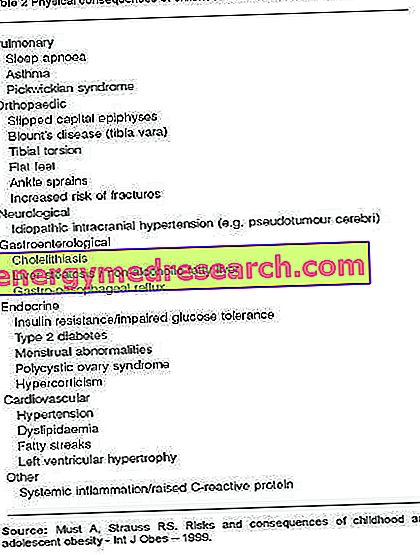By Dr. Davide Sganzerla
Until recently, the complications of childhood obesity were clinically evident only after many years. Clinical studies of obese children have suggested a number of medical conditions for which obese children are at greatest risk. As shown in Table 2, there are few apparatuses that severe obesity does not affect. These conditions are important because they are very common, potentially serious, and responsible for serious consequences for the health and well-being of life.

Among all the consequences of obesity, the most frequent are represented by pulmonary disorders (fatigability of the breath, sleep apnea and asthma), and of an orthopedic type.
Respiratory disorders during sleep are very frequent in children in excess of weight and refer to a wide range of conditions that include increased resistance to air flow through the upper airway, the consequent reduction in the flow of air. air and finally the cessation of breath. (Riley, 1976).
Asthma and its symptoms are a difficult subject of study and the link between excess weight and asthma should not be assumed: children with asthma must reduce their level of physical activity, and the medical treatment of asthma (cortisone therapy), can cause weight gain. (Rodriguez, 2002).
Nonetheless, the observation that weight loss can improve lung function in obese adults suggests that the prevention of obesity can decrease asthma, or better prevent its occurrence. (Stenius-Aarniala, 2000).
Orthopedic complications are due to the excessive mechanical load that bones and joints bear. Flat feet, varus and lower limb valgus are the most common paramorphisms. Not only that, excess weight can cause joint pain, reduce mobility and increase the risk of sprains and fractures. (Confalone, 2002).
As for the late consequences, it should be emphasized that childhood obesity is a predictor of obesity in adulthood. In addition to having a greater predisposition to overweight and obesity, the person who has been in excess of weight as a child is more exposed to certain pathologies, above all of a cardiovascular nature such as arterial hypertension and dyslipidemia (increase in triglycerides and cholesterol in the blood); all because of the wrong lifestyle typical of the obese. (Must, 1999).
The endocrine-type consequences are also serious, such as type 2 diabetes (insulin-resistant), typical of adults but also frequent among obese and overweight children (Scott, 1997), and hypersurenalism, that is the hypersecretion of corticosteroid hormones by the adrenal gland (Must, 1999).
Menstrual abnormalities, early menarche and polycystic ovaries, represent endocrine responses to excess weight in girls (Rogers, 1956), while overweight or obese children tend to develop later than peers in weight form. (Wang, 2002).
From the gastrointestinal point of view, obesity can cause minor complications, such as simple eating disorders, but also serious consequences, such as cholelithiasis (presence of stones formed by cholesterol inside the bile ducts or gall bladder), hepatic steatosis (degenerative process of liver tissue due to the massive presence of fatty tissue in the liver), and tumors of the gastrointestinal tract. (Must, 1999).
Not to underestimate the psychological consequences, which can drag on and amplify over the years. Children in excess of weight can feel uncomfortable and ashamed, up to a real rejection of their physical appearance; they are often derided children, victims of jokes by their peers and at the risk of losing self-esteem and develop a sense of insecurity that can lead them to isolation: they leave less than home and spend more time in front of the television, establishing a vicious circle that leads them to reactive over-feeding. (Confalone, 2002).
Finally, the economic consequences that obesity in general causes are also to be mentioned. A real calculation of the costs for childhood obesity is very difficult to make. as you would need a methodology that also takes into account the costs for associated disorders. However, numerous studies have evaluated the costs incurred by the various health systems of many industrialized countries for obesity in general. As shown in Table 3, these studies suggest that the costs for obesity range between 2 and 7% of the total health costs of these countries.

Even these data, however, are not totally truthful, as they do not take into account the costs for diseases and problems related to obesity. For example, hepatic steatosis (linked to obesity) is the third common cause for liver transplantation in many industrialized countries, and therefore represents a significant medical expense not included among the total costs of obesity.



